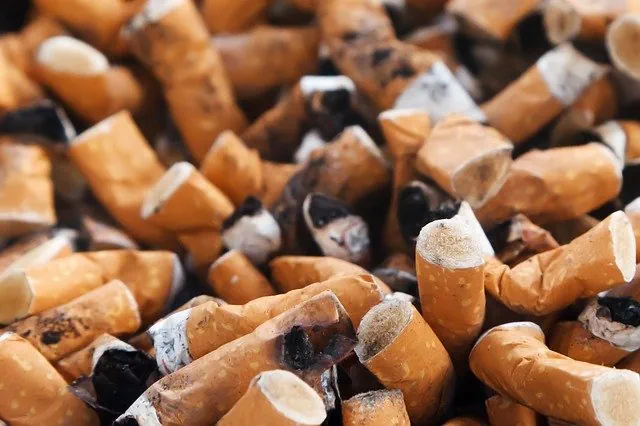
How Does Smoking Pollute the Environment?

Table of Contents
Smoking pollutes the environment in several ways and causes over 480,000 death every year in the US. This means it causes more deaths in the country than HIV AIDS, illegal drug use, motor vehicle injuries, alcohol use, and firearm-related damages combined. Remember, this figure refers to the deaths related to tobacco smoking alone. In the present age, electronic smoking, also known as e-cigarette smoking, is also on the increase, and studies have shown that it might have a more disastrous impact on the environment than tobacco.

Man smoking tobacco - pixabay
How does smoking pollute the environment? This is the question we want to answer in detail in this article. Due to the harmful effects of smoking, we should come up with the most effective ways to minimize it. That’s only possible if we work together and understand how smoking pollutes the Earth and what that means. Now, let’s dive deeper into all the essential details below.
Tobacco Growing Depletes Natural Resources
The tobacco-growing market in the US is USD 859.6 million in 2021. The leading tobacco-growing states include Kentucky, North Carolina, and Virginia. North Carolina is part of the Virginia-Carolina tobacco belt that topped the list of tobacco producers in the country in 2016.
In 2011, approximately 4,200,000 hectares of land across the world was dedicated to tobacco growing. In some middle- and low-income countries, the percentage has increased drastically over the years.
The increase in Tobacco farming might significantly affect the environment in the following ways:
Increase Deforestation
A credible study shows that tobacco farming was responsible for at least 4% of deforestation globally by 2016. The fraction is likely higher today due to population growth. In some countries, farmers currently use the slash-and-burn method, which leads to an increase in the amount of carbon dioxide in the atmosphere. The global warming and climate change challenge has been worsening due to the reducing the number of natural carbon sinks.
Overuse of Farming chemicals
Tobacco farmers use a lot of pesticides, growth regulators, and fertilizers to increase their crop yield. Due to poor runoff from tobacco growing areas, the rate at which the world’s drinking water sources are polluted increases.
Deplete Soil Nutrients
Tobacco takes up many nutrients, including phosphorous, potassium, and nitrogen, from the soil. In other words, tobacco farming can deplete soil nutrients and make the land unproductive. This reduces the land cover, which is essential for removing excess carbon dioxide from the air.
Tobacco Use Releases Toxins
The health impact of the consumption of tobacco is an indicator of its effect on the environment. Smoke has been linked to several diseases, including lung cancer, pulmonary disease, and cardiovascular disease.
As already mentioned, smoking causes significantly more deaths than HIV AIDS, illegal drug use, motor vehicle injuries, alcohol use, and firearm-related damages combined. Remember, tobacco smoke contains more than 7,000 chemicals. At least 250 of these substances are known to be dangerous to the environment and human health. Examples of these hazardous chemicals are hydrogen cyanide, ammonia, and carbon monoxide.
Tobacco smokers live in highly polluted environments and constantly come into direct contact with toxic gases and substances. Due to this, they typically die ten years earlier than non-smokers.
Some people don’t think this is serious enough. I understand that their argument that suggests tobacco smoking could be aiding in preserving the environment by eliminating polluters ten years before their time is insensitive and wrong.
The pro-smoking crusaders’ idea is that death is a natural solution to environmental pollution. However, there’s no evidence to support the claim. We can see that more animals and plants have become endangered today than before due to smoking and other factors. So, it’s wrong to think that smokers are the problem. Smoking is the issue. In other words, if everyone begins to take care of the environment, the death rate can decline.
Please note that smoking claims the lives of innocent bystanders like children and pets too. Non-smokers can also prematurely die or suffer when they inhale the residual chemicals in the polluted air.
Tobacco Butts and E-Cigarette Wastes Litter the Environment
Most people discard cigarette butts after smoking. These wastes make up between 30% and 40% of the collected items in annual coastal and urban cleanups. This is true in all parts of the world.
In some parts of the US, you might find cigarette butts on roadways, loading docks, recreational areas, construction sites, retail areas, and storm drains. In 2019, 900 178 cigarette butts were collected in the US beaches and waterways. During the same period, 4, 211, 963 cigarette butts were collected globally.

Cigarette butts - pixabay
Most of the litter contains dangerous substances like arsenic, nicotine, lead, and ethyl phenol. These chemicals are often leached from the butts into the soil and aquatic environments, killing microorganisms, fish, and other animals that play an essential role in the food chain.
It might appear like this is a short-term problem due to the emergence of e-cigarettes. Unfortunately, that’s far from the truth. E-cigarette-related waste contains toxic metals, batteries, single-use plastic cartridges, circuitry, and dangerous substances in e-liquids. To make matters worse, most e-cigarettes device owners lack the required disposal information. Others are not prepared to take their time to dispose of the devices in the right way due to the lack of risk awareness.
Smoking Wastes are Non-Biodegradable
The littering issue might not be the most severe impact of smoking. The cellulose acetate filter in cigarettes is non-biodegradable, meaning it’s highly likely to take more than a year to break down into ecologically benign components. The cellulose acetate filter is a plastic-like material, and that’s why it’s non-biodegradable.
It might take almost one year for a cigarette butt to degrade under optimal conditions. The sun can also break it down into small pieces. But this doesn’t guarantee you safety. The tiny particles can still pollute the soil and water bodies.
E-cigarette wastes are more dangerous, as they cannot biodegrade under any condition. Please note that all materials can degrade after some time. So, what we mean here is that e-cigarette wastes can biodegrade after approximately 12 years, making it a severe long-term threat to the environment.

Electronic cigarette - pixabay
When smokers discard e-cigarette wastes on the street, they mix with lead litter and break down into microplastics and chemicals. These particles eventually flow into storm drains and pollute waterways and wildlife. When humans consume the affected animals or use the water, they get exposed to severe health risks.
Smoking Causes Fires
Smoking has been one of the major causes of residential fires for decades. Whenever you hear or read about the thousands of homes and apartments that are burnt down across the world, you can rightly suspect improperly discarded cigarette butts as the culprit. The fires destroy chemicals that should be disposed of in a safe and professional way for environmental safety reasons. Of course, it also produces more carbon dioxide and other dangerous gases than the natural and artificial carbon sinks can absorb.
Smoking also contributes to wildfires, leaving most wild animals homeless.

Cigarette butt fire hazard - pixabay
Careless tossing of burning cigarettes remains a significant threat to forests. Throwing extinguished cigarette butts also increases the risk since the non-biodegradable plastic material they are made of is highly combustible.
Smoking-Environmental Spending Hinders Mitigation Efforts
Some governments, non-governmental organizations, and individuals have understood how smoking pollutes the environment and the consequences. The US has been spending a lot of money on environmental conservation efforts for several decades. In 1998 alone, smoking-related fires cost the United States approximately 7 billion dollars. Due to the increasing population, you can imagine how current and future expenditure plans look like. Other than individuals and private entities, some countries have been spending lots of money to preserve the environment and protect lives and properties. Don’t you think that’s recommendable? I know you do.
However, the high number of smokers today negates the impact of environmental conservation efforts. We might not have enough time to calculate the amount of money that the US government has contributed for the last 20 years to clean up the mess that smoking has caused around the world right now. However, you can tell that it could number trillions of US dollars.
Given the current global warming and climate change trend, the world still needs to increase spending on environmental conservation to minimize smoking and its impact. For example, more funds should be directed towards research on e-cigarette smoking to discover the best ways to reduce its adverse effects.
The lack of adequate funds limits the ability of governments, individuals, and non-governmental organizations to address the problems caused by smoking. Think about e-cigarette smoking. It has been considered a significant way to reduce the carbon footprint. Nevertheless, as already shared here, that’s not the case. The technology behind it is complex and might cause more problems. More resources are required to find the solution.
What You Can Do
Now you know how smoking pollutes the environment. We’ve seen how cigarettes and electronic cigarettes are dangerous and threaten to wipe life from the surface of the Earth. But that’s not enough. It’s time to apply the knowledge we’ve shared here to reduce the impact of smoking. One thing that we can do is educate smokers on the short- and long-term effects of smoking.
Another solution is to work closely with governments’ executive and legislature arms to pass and implement strict laws geared towards saving a life. Help leaders in your area understand that smoking causes more deaths than HIV AIDS, illegal drug use, motor vehicle injuries, alcohol use, and firearm-related damages combined, and you could begin to reap the desired results.